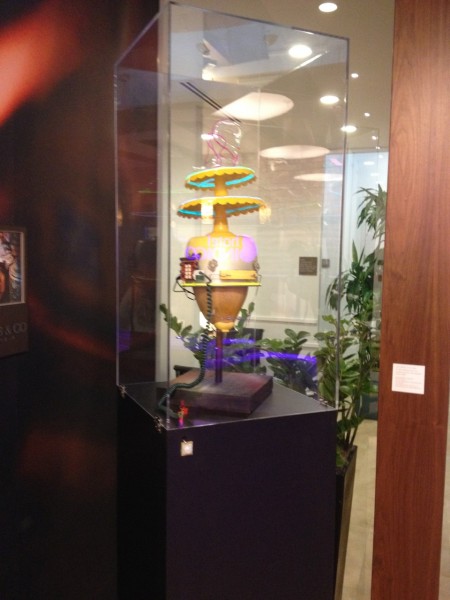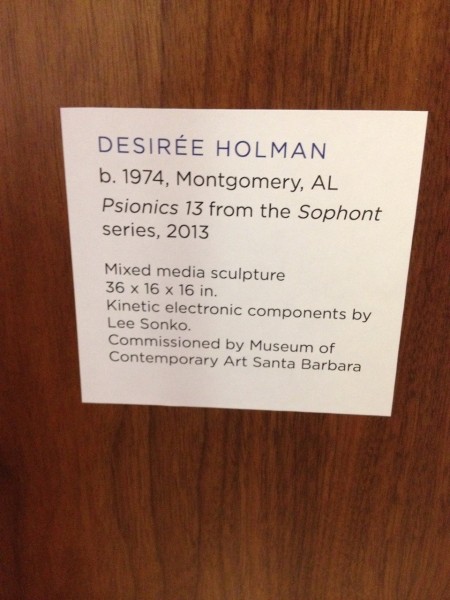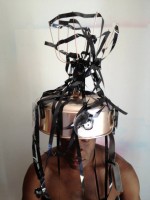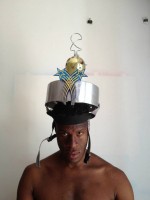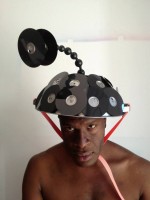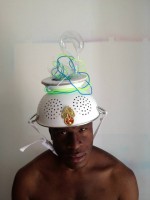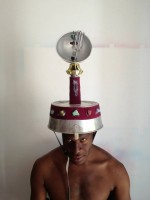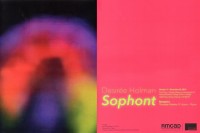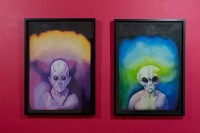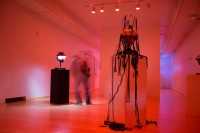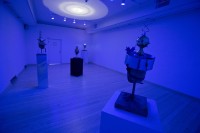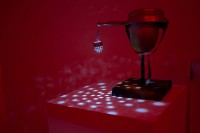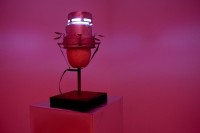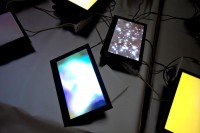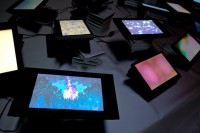You might think the following article is about the psychology behind wacky food crazes, and it is. But it isn’t. But it is, at a much deeper level than you think. It is very worthwhile to read and contemplate.
How did toast become the latest artisanal food craze? Ask a trivial question, get a profound, heartbreaking answer.
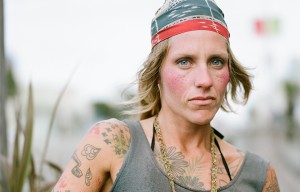
All the guy was doing was slicing inch-thick pieces of bread, putting them in a toaster, and spreading stuff on them. But what made me stare–blinking to attention in the middle of a workday morning as I waited in line at an unfamiliar cafeÌ–was the way he did it. He had the solemn intensity of a Ping-Pong player who keeps his game very close to the table: knees slightly bent, wrist flicking the butter knife back and forth, eyes suggesting a kind of flow state.
The coffee shop, called the Red Door, was a spare little operation tucked into the corner of a chic industrial-style art gallery and event space (clients include Facebook, Microsoft, Evernote, Google) in downtown San Francisco. There were just three employees working behind the counter: one making coffee, one taking orders, and the soulful guy making toast. In front of him, laid out in a neat row, were a few long Pullman loaves–the boxy Wonder Bread shape, like a train car, but recognizably handmade and freshly baked. And on the brief menu, toast was a standalone item–at $3 per slice.
It took me just a few seconds to digest what this meant: that toast, like the cupcake and the dill pickle before it, had been elevated to the artisanal plane. So I ordered some. It was pretty good. It tasted just like toast, but better.
A couple of weeks later I was at a place called Acre Coffee in Petaluma, a smallish town about an hour north of San Francisco on Highway 101. Half of the shop’s food menu fell under the heading “Toast Bar.” Not long after that I was with my wife and daughter on Divisadero Street in San Francisco, and we went to The Mill, a big light-filled cafe and bakery with exposed rafters and polished concrete floors, like a rustic Apple Store. There, between the two iPads that served as cash registers, was a small chalkboard that listed the day’s toast menu. Everywhere the offerings were more or less the same: thick slices of good bread, square-shaped, topped with things like small-batch almond butter or apricot marmalade or sea salt.
Back at the Red Door one day, I asked the manager what was going on. Why all the toast? “Tip of the hipster spear,” he said.
I had two reactions to this: First, of course, I rolled my eyes. How silly; how twee; how perfectly San Francisco, this toast. And second, despite myself, I felt a little thrill of discovery. How many weeks would it be, I wondered, before artisanal toast made it to Brooklyn, or Chicago, or Los Angeles? How long before an article appears in Slate telling people all across America that they’re making toast all wrong? How long before the backlash sets in?
For whatever reason, I felt compelled to go looking for the origins of the fancy toast trend. How does such a thing get started? What determines how far it goes? I wanted to know. Maybe I thought it would help me understand the rise of all the seemingly trivial, evanescent things that start in San Francisco and then go supernova across the country–the kinds of products I am usually late to discover and slow to figure out. I’m not sure what kind of answer I expected to turn up. Certainly nothing too impressive or emotionally affecting. But what I found was more surprising and sublime than I could have possibly imagined.
 IF THE DISCOVERY OFartisanal toast had made me roll my eyes, it soon made other people in San Francisco downright indignant. I spent the early part of my search following the footsteps of a very low-stakes mob. “$4 Toast: Why the Tech Industry Is Ruining San Francisco” ran the headline of an August article on a local technology news site called VentureBeat.
IF THE DISCOVERY OFartisanal toast had made me roll my eyes, it soon made other people in San Francisco downright indignant. I spent the early part of my search following the footsteps of a very low-stakes mob. “$4 Toast: Why the Tech Industry Is Ruining San Francisco” ran the headline of an August article on a local technology news site called VentureBeat.
“Flaunting your wealth has been elevated to new lows,” wrote the author, Jolie O’Dell. “We don’t go to the opera; we overspend on the simplest facets of life.” For a few weeks $4 toast became a rallying cry in the city’s media–an instant parable and parody of the shallow, expensive new San Francisco–inspiring thousands of shares on Facebook, several follow-up articles, and a petition to the mayor’s office demanding relief from the city’s high costs of living.
The butt of all this criticism appeared to be The Mill, the rustic-modern place on Divisadero Street. The Mill was also, I learned, the bakery that supplies the Red Door with its bread. So I assumed I had found the cradle of the toast phenomenon.
I was wrong. When I called Josey Baker, the–yes–baker behind The Mill’s toast, he was a little mystified by the dustup over his product while also a bit taken aback at how popular it had become. “On a busy Saturday or Sunday we’ll make 350 to 400 pieces of toast,” he told me. “It’s ridiculous, isn’t it?”
But Baker assured me that he was not the Chuck Berry of fancy toast. He was its Elvis: he had merely caught the trend on its upswing. The place I was looking for, he and others told me, was a coffee shop in the city’s Outer Sunset neighborhood–a little spot called Trouble.
THE TROUBLE COFFEE & Coconut Club (its full name) is a tiny storefront next door to a Spanish-immersion preschool, about three blocks from the Pacific Ocean in one of the city’s windiest, foggiest, farthest-flung areas. As places of business go, I would call Trouble impressively odd.
Instead of a standard cafeÌ patio, Trouble’s outdoor seating area is dominated by a substantial section of a tree trunk, stripped of its bark, lying on its side. Around the perimeter are benches and steps and railings made of salvaged wood, but no tables and chairs. On my first visit on a chilly September afternoon, people were lounging on the trunk drinking their coffee and eating slices of toast, looking like lions draped over tree limbs in the Serengeti.
The shop itself is about the size of a single-car garage, with an L-shaped bar made of heavily varnished driftwood. One wall is decorated with a mishmash of artifacts–a walkie-talkie collection, a mannequin torso, some hand tools. A set of old speakers in the back blares a steady stream of punk and noise rock. And a glass refrigerator case beneath the cash register prominently displays a bunch of coconuts and grapefruit. Next to the cash register is a single steel toaster. Trouble’s specialty is a thick slice of locally made white toast, generously covered with butter, cinnamon, and sugar: a variation on the cinnamon toast that everyone’s mom, including mine, seemed to make when I was a kid in the 1980s. It is, for that nostalgic association, the first toast in San Francisco that really made sense to me.
Trouble’s owner, and the apparent originator of San Francisco’s toast craze, is a slight, blue-eyed, 34-year-old woman with freckles tattooed on her cheeks named Giulietta Carrelli. She has a good toast story: She grew up in a rough neighborhood of Cleveland in the ’80s and ’90s in a big immigrant family, her father a tailor from Italy, her mother an ex-nun. The family didn’t eat much standard American food. But cinnamon toast, made in a pinch, was the exception. “We never had pie,” Carrelli says. “Our American comfort food was cinnamon toast.”
It was perhaps the safe distance between them–an elderly man and a young woman sitting on a public beach–that made Glen relatively impervious to the detonations that had wiped out every other home Giulietta had ever had. “He couldn’t kick me out,” she says.
The other main players on Trouble’s menu are coffee, young Thai coconuts served with a straw and a spoon for digging out the meat, and shots of fresh-squeezed grapefruit juice called “Yoko.” It’s a strange lineup, but each item has specific meaning to Carrelli. Toast, she says, represents comfort. Coffee represents speed and communication. And coconuts represent survival–because it’s possible, Carrelli says, to survive on coconuts provided you also have a source of vitamin C. Hence the Yoko. (Carrelli tested this theory by living mainly on coconuts and grapefruit juice for three years, “unless someone took me out to dinner.”)
The menu also features a go-for-broke option called “Build Your Own Damn House,” which consists of a coffee, a coconut, and a piece of cinnamon toast. Hanging in the door is a manifesto that covers a green chalkboard. “We are local people with useful skills in tangible situations,” it says, among other things. “Drink a cup of Trouble. Eat a coconut. And learn to build your own damn house. We will help. We are building a network.”
If Trouble’s toast itself made instant sense to me, it was less clear how a willfully obscure coffee shop with barely any indoor seating in a cold, inconvenient neighborhood could have been such a successful launch pad for a food trend. In some ways, the shop seemed to make itself downright difficult to like: It serves no decaf, no non-fat milk, no large drinks, and no espressos to go. On Yelp, several reviewers report having been scolded by baristas for trying to take pictures inside the shop with their phones. (“I better not see that up on Instagram!” one reportedly shouted.)
Nevertheless, most people really seem to love Trouble. On my second visit to the shop, there was a steady line of customers out the door. After receiving their orders, they clustered outside to drink their coffees and eat their toast. With no tables and chairs to allow them to pair off, they looked more like neighbors at a block party than customers at a cafeÌ. And perhaps most remarkably for San Francisco, none of them had their phones out.
Trouble has been so successful, in fact, that Carrelli recently opened a second, even tinier location in the city’s Bayview neighborhood. I met her there one sunny afternoon. She warned me that she probably wouldn’t have much time to talk. But we chatted for nearly three hours.
In public, Carrelli wears a remarkably consistent uniform: a crop top with ripped black jeans and brown leather lace-up boots, with her blond hair wrapped in Jack Sparrowish scarves and headbands. At her waist is a huge silver screaming-eagle belt buckle, and her torso is covered with tattoos of hand tools and designs taken from 18th-century wallpaper patterns. Animated and lucid–her blue eyes bright above a pair of strikingly ruddy cheeks–Carrelli interrupted our long conversation periodically to banter with pretty much every person who visited the shop.
At first, Carrelli explained Trouble as a kind of sociological experiment in engineering spontaneous communication between strangers. She even conducted field research, she says, before opening the shop. “I did a study in New York and San Francisco, standing on the street holding a sandwich, saying hello to people. No one would talk to me. But if I stayed at that same street corner and I was holding a coconut? People would engage,” she said. “I wrote down exactly how many people talked to me.”
The smallness of her cafeÌs is another device to stoke interaction, on the theory that it’s simply hard to avoid talking to people standing nine inches away from you. And cinnamon toast is a kind of all-purpose mollifier: something Carrelli offers her customers whenever Trouble is abrasive, or loud, or crowded, or refuses to give them what they want. “No one can be mad at toast,” she said.
Carrelli’s explanations made a delightfully weird, fleeting kind of sense as I heard them. But then she told me something that made Trouble snap into focus. More than a cafeÌ, the shop is a carpentered-together, ingenious mechanism–a specialized tool–designed to keep Carrelli tethered to herself.

EVER SINCE SHE WAS in high school, Carrelli says, she has had something called schizoaffective disorder, a condition that combines symptoms of schizophrenia and bipolarity. People who have it are susceptible to both psychotic episodes and bouts of either mania or depression.
Carrelli tends toward the vivid, manic end of the mood spectrum, she says, but the onset of a psychotic episode can shut her down with little warning for hours, days, or, in the worst instances, months. Even on good days, she struggles to maintain a sense of self; for years her main means of achieving this was to write furiously in notebooks, trying to get the essentials down on paper. When an episode comes on, she describes the experience as a kind of death: Sometimes she gets stuck hallucinating, hearing voices, unable to move or see clearly; other times she has wandered the city aimlessly. “Sometimes I don’t recognize myself,” she says. “I get so much disorganized brain activity, I would get lost for 12 hours.”
Carrelli’s early years with her illness were, she says, a blind struggle. Undiagnosed, she worked her way through college–three different colleges, in different corners of the country–by booking shows for underground bands and doing stints at record stores and coffee shops. But her episodes were a kind of time bomb that occasionally leveled any structure in her life. Roommates always ended up kicking her out. Landlords evicted her. Relationships fell apart. Employers either fired her or quietly stopped scheduling her for shifts. After a while, she began anticipating the pattern and taking steps to pre-empt the inevitable. “I moved when people started catching on,” she says. By the time she hit 30, she had lived in nine different cities.
Like a lot of people with mental illness, Carrelli self-medicated with drugs, in her case opiates, and alcohol. And sometimes things got very bad indeed. Throughout her 20s, she was in and out of hospitals and periods of homelessness.
One day in 1999, when Carrelli was living in San Francisco and going to school at the University of California-Berkeley, she took a long walk through the city and ended up on China Beach, a small cove west of the Golden Gate. She describes the scene to me in stark detail: The sun was flickering in and out of intermittent fog. A group of Russian men in Speedos were stepping out of the frigid ocean. And an elderly man was sitting in a deck chair, sunbathing in weather that suggested anything but. Carrelli struck up a conversation with the man, whose name was Glen. In a German accent, he told her that people congregated regularly at China Beach to swim in the ocean. He had done so himself when he was younger, he said, but now he just came to the beach to sunbathe every day.
“I’m wearing the same outfit every day,” Carrelli says. “I take the same routes. I own Trouble Coffee so that people recognize my face–so they can help me.”
Carrelli left San Francisco shortly thereafter. (“Everything fell apart,” she says.) But her encounter with the old man made such a profound impression that five years later, in 2004–after burning through stints in South Carolina, Georgia, and New York–she drove back across the country and headed for China Beach. When she arrived, she found Glen sitting in the same spot where she had left him in 1999. That day, as they parted ways, he said, “See you tomorrow.” For the next three years, he said the same words to her pretty much every day. “He became this structure,” Carrelli says, “a constant.”
It was perhaps the safe distance between them–an elderly man and a young woman sitting on a public beach–that made Glen relatively impervious to the detonations that had wiped out every other home she’d ever had. “He couldn’t kick me out,” Carrelli says. She sat with her notebooks, and Glen asked her questions about her experiments with strangers and coconuts. Gradually, she began to find other constants. She started joining the swimmers every day, plunging into the Pacific with no wetsuit, even in winter. Her drinking began to taper off. She landed a job at a coffee shop called Farley’s that she managed to keep for three years. And she began assiduously cultivating a network of friends she could count on for help when she was in trouble–a word she uses frequently to refer to her psychotic episodes–while being careful not to overtax any individual’s generosity.
Carrelli also found safety in simply being well-known–in attracting as many acquaintances as possible. That’s why, she tells me, she had always worked in coffee shops. When she is feeling well, Carrelli is a swashbuckling presence, charismatic and disarmingly curious about people. “She will always make a friend wherever she is,” says Noelle Olivo, a San Francisco escrow and title agent who was a regular customer at Farley’s and later gave Carrelli a place to stay for a couple of months. “People are taken aback by her, but she reaches out.”
This gregariousness was in part a survival mechanism, as were her tattoos and her daily uniform of headscarves, torn jeans, and crop tops. The trick was to be identifiable: The more people who recognized her, the more she stood a chance of being able to recognize herself.
But Carrelli’s grip on stability was still fragile. Between apartments and evictions, she slept in her truck, in parks, at China Beach, on friends’ couches. Then one day in 2006, Carrelli’s boss at Farley’s Coffee discovered her sleeping in the shop, and he told her it was probably time she opened up her own space. “He almost gave me permission to do something I knew I should do,” she recalls. It was clear by then that Carrelli couldn’t really work for anyone else–Farley’s had been unusually forgiving. But she didn’t know how to chart a course forward. At China Beach, she took to her notebooks, filling them with grandiose manifestoes about living with guts and honor and commitment–about, she wrote, building her own damn house.
“Giulietta, you don’t have enough money to eat tonight,” Glen said, bringing her down to Earth. Then he asked her a question that has since appeared in her writing again and again: “What is your useful skill in a tangible situation?”
The answer was easy: she was good at making coffee and good with people. So Glen told her it was time she opened a checking account. He told her to go to city hall and ask if they had information on starting a small business. And she followed his instructions.
With $1,000 borrowed from friends, Carrelli opened Trouble in 2007 in a smelly, cramped, former dog grooming business, on a bleak commercial stretch. She renovated the space pretty much entirely with found materials, and with labor and advice that was bartered for, cajoled, and requested from her community of acquaintances.
She called the shop Trouble, she says, in honor of all the people who helped her when she was in trouble. She called her drip coffee “guts” and her espresso “honor.” She put coconuts on the menu because of the years she had spent relying on them for easy sustenance, and because they truly did help her strike up conversations with strangers. She put toast on the menu because it reminded her of home: “I had lived so long with no comfort,” she says. And she put “Build Your Own Damn House” on the menu because she felt, with Trouble, that she had finally done so.
The trick was to be identifiable: the more people who recognized her, the more she stood a chance of being able to recognize herself.
GLEN–WHOSE FULL NAMEwas Gunther Neustadt, and who had escaped Germany as a young Jewish boy with his twin sister during World War II–lived to see Trouble open. But he died later that year. In 2008, Carrelli became pregnant and had twins, and she named one of them after her friend from China Beach.
That same year, after having lived in her shop for months, Carrelli got a real apartment. She went completely clean and sober, and has stayed that way. She started to hire staff she could rely on; she worked out a sustainable custody arrangement with her children’s father. And Trouble started to get written up in the press. Customers began to flock there from all over town for toast and coffee and coconuts.
The demands of running the shop, caring for two children, and swimming every day allowed Carrelli to feel increasingly grounded, but her psychotic episodes hardly went away; when they came on, she just kept working somehow. “I have no idea how I ran Trouble,” she says. “I kept piling through.” In 2012, after a five-month episode, Carrelli was hospitalized and, for the first time, given the diagnosis of schizoaffective disorder. Under her current treatment regimen, episodes come far less frequently. But still they come.
At bottom, Carrelli says, Trouble is a tool for keeping her alive. “I’m trying to stay connected to the self,” she says. Like one of her old notebooks, the shop has become an externalized set of reference points, an index of Carrelli’s identity. It is her greatest source of dependable routine and her most powerful means of expanding her network of friends and acquaintances, which extends now to the shop’s entire clientele. These days, during a walking episode, Carrelli says, a hello from a casual acquaintance in some unfamiliar part of the city might make the difference between whether she makes it home that night or not. “I’m wearing the same outfit every day,” she says. “I take the same routes every day. I own Trouble Coffee so that people recognize my face–so they can help me.”
After having struggled as an employee in so many coffee shops, she now employs 14 people. In an almost unheard of practice for the cafeÌ business, she offers them profit-sharing and dental coverage. And she plans on expanding the business even further, maybe opening up to four or five locations. With the proceeds, she hopes to one day open a halfway house for people who have psychotic episodes–a safe place where they can go when they are in trouble.
WHEN I TOLD FRIENDS back East about the craze for fancy toast that was sweeping across the Bay Area, they laughed and laughed. (How silly; how twee; how San Francisco.) But my bet is that artisanal toast is going national. I’ve already heard reports of sightings in the West Village.
If the spread of toast is a social contagion, then Carrelli was its perfect vector. Most of us dedicate the bulk our attention to a handful of relationships: with a significant other, children, parents, a few close friends. Social scientists call these “strong ties.” But Carrelli can’t rely on such a small set of intimates. Strong ties have a history of failing her, of buckling under the weight of her illness. So she has adapted by forming as many relationships–as many weak ties–as she possibly can. And webs of weak ties are what allow ideas to spread.
In a city whose economy is increasingly built on digital social networks–but where simple eye contact is at a premium–Giulietta Carrelli’s latticework of small connections is old-fashioned and analog. It is built not for self-presentation, but for self-preservation. And the spread of toast is only one of the things that has arisen from it.
A few weeks ago, I went back to Trouble because I hadn’t yet built my own damn house. When my coconut came, the next guy at the bar shot me a sideways glance. Sitting there with a slice of toast and a large tropical fruit, I felt momentarily self-conscious. Then the guy said to the barista, “Hey, can I get a coconut too?” and the two of us struck up a conversation.
This post originally appeared in the January/February 2014 issue ofPacific Standard as “A Toast Story.” For more, consider subscribing to our bimonthly print magazine.
